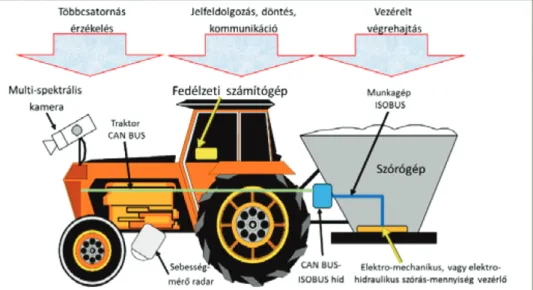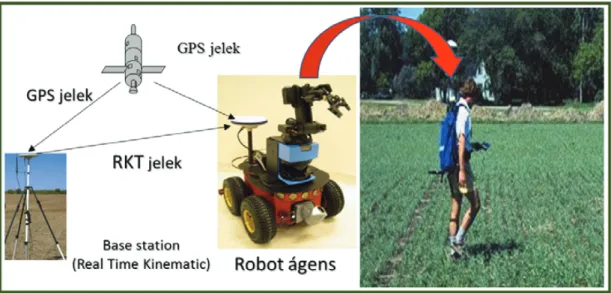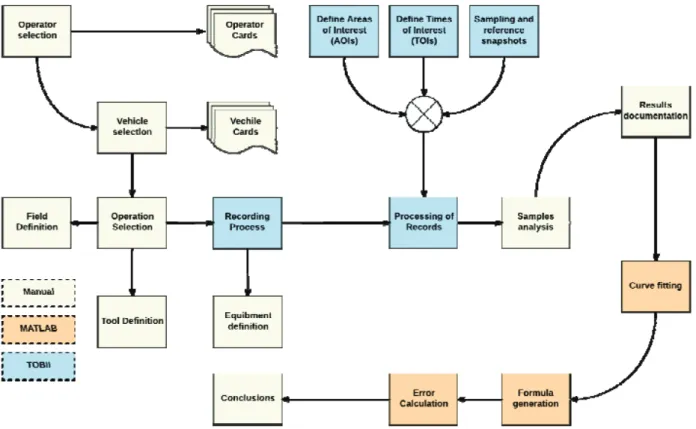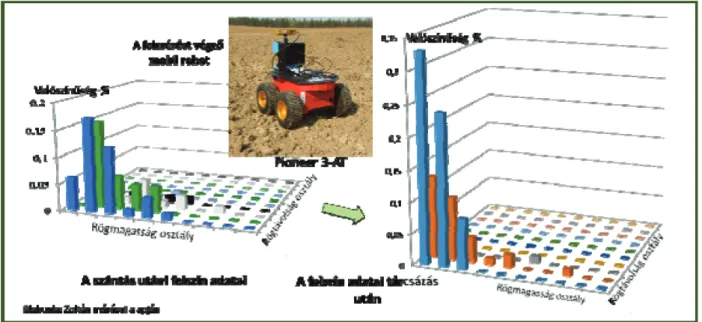Abstract
There are many concept and technology to robotize in agriculture. The robotization has an intensive synergy with artificial intelligence (AI), information and communication technology (ICT) and sensor technology (ST). These technologies drive into the 4th revolution industry. The industrial processes help the automatization in agriculture. The demand for food products are growing, the working force getting old, these impacts forces the robot applications. This article introduce the robots in the agriculture, and the Szent István University current research on the fields.
Keywords
robots, artificial intelligence, sensor technology, smart farming
Introduction
What is a robot? In general robot is every entity which able to sense the environment, process, and acting based on dynamical changing environment.
The most important properties are: sensing, autonomy intelligence, adaptive behaviour and working, able to acting. Another important capability: communication and cooperation. In the agriculture the environment is very challenging. The robot swarm can be a good solution for dynamically changing environment and complex task.
From Industry 4.0 to Agricultural 4.0
According to some definitions, Industry 4.0 is a frame of automation and data exchange in manufacturing technologies. It includes cyber-physical systems, the Internet of Things and cloud computing. Industry 4.0 includes all those innovative solution, methods that can compose an intelligent production system called
„Smart Factory”. Within the modular structured smart factories, cyber-physical systems monitor physical processes, create a virtual copy of the physical world and make decentralized decisions. Over the IoT, cyber-physical systems communicate and cooperate with each other and with humans in real time, and via the Internet of Services. Both internal and cross- organizational services offered and used by participants of the value chain. Cloud computing is already a well-known IT technology. It has the following five features: on-demand service, internet access, resource polling, rapid elasticity and calculability. In this way some sensors –controlling the process- connect to the internet ensuring the adequate information. The so called “Smart Agriculture” based on Cloud Computing, and IoT realize concentrated management and control of machine, equipment and personnel, based on the internet and improve production through more detailed and dynamic means. This is useful for effective integration between human society and the physical world, and regards as the third wave of information industry development following computerisation and internet. IoT technologies include RFID, sensor network technology, and internetwork communication, all of which have been involved in the four links of IoT industrial chain, namely: identification, sensing, processing and information delivery [1].
Agriculture 4.0 -analogy to Industry 4.0- stands for the integrated internal and external networking of farm operations. Information in digital form exists for all farm sectors and processes; communication with external partners - suppliers and end customers- is performed electronically; and data transmission, processing and analysis are largely automated. The use of Internet-based portals can facilitate the handling of large volumes of data, as well as networking within the farm and with external partners [2].
HUNGARIAN AGRICULTURAL ENGINEERING N° 36/2019 22-28
Published online: http://hae-journals.org/
HU ISSN 0864-7410 (Print) / HU ISSN 2415-9751(Online) DOI: 10.17676/HAE.2019.336.22
SYNERGY OF ROBOTICS AND ICT IN THE SMART FARMING
Author(s):
Z. Bártfai, Z. Blahunka, L. Kátai and I. Szabó Affiliation:
Department of Physics and Process Control, Szent István University, Páter K. u. 1., Gödöllő, H-2103, Hungary Email address:
Blahunka.zoltan@gek.szie.hu
PERIODICAL OF THE COMITTEE OF AGRICULTURAL AND BIOSYSTEM ENGINEERING OF
THE HUNGARIAN ACADEMY OF SCIENCES and
SZENT ISTVÁN UNIVERSITY Faculty of Mechanical Engineering Received: 2019.10. 05. - Accepted: 2019.12. 28.
Other terms frequently used are “Smart Agriculture” and “Digital Farming”. It is based on the emergence of smart technology in agriculture. Smart devices consist of sensors, actuators and communication technology.
Specialities
Another very important working condition is the livestock and bio materials. These materials are very sensitive and vulnerable. Figure 1 shows same sample for harvesting.
Figure 1. Bio materials
Figure 2. Real time on-board calculation Section aand cshows mechanical grippers. In the
section c the robot use 3D camera for positioning.
Section b presents a vacuum gripper, which has a very soft touch.
Sensing the environment is the most important area on agriculture robotization. There are limitations on resolution, range.
Sample: steering
Nowadays autonomous steering getting more popular in the fields. The autonomous unit works on total field, save the tracks and turns. It is able to repeat the whole process autonomously. The sensing base is the Real Time Kinematic (RTK) system. Inertial Measurement Unit (IMU), angle sensors, adaptive
controller are for current steering angle. The system is able the turn back at the end of the line, make the working conditions more comfortable for the operator.
Variable Rate Control
One definition for precision agriculture is the location based acting. Location means every plant gets the optimal chemicals, seeds etc. The field is not a homogeny area, there can be differential demands.
The map can be predefined or based on-board calculation. The communication is the general used CAN BUS. Connecting of the smart implements is realised through ISOBUS. ISOBUS connects the tractor ECU to the implement ECU [3].
Figure 2 shows a tractor using camera for sensing, CAN bus, ISOBUS for data communication and sprayer with variable rate control and section control.
Mini robots and drones
These fields have a big extension. For precision agriculture is an important input value what can be static or dynamic based on time or location.
Environment protection is getting more important.
Using less (optimal) quantity of chemicals is not only an economical question but environmental too.
Collect information from a large area usually use aerial or satellite photos. Drones are getting popular in agriculture too.
Monitoring systems can be:
– Mobil robots – Drones – Robot swarm.
Currently the development of autonomous soil monitoring systems/robots is in the focus. These sensing technologies can be autonomous or build in tractors. In the EU there are providers for field level aerial photos from drones. They use colour and infra cameras for sensing. The scanning be real time. There are many processes to post process. The infra photos are very useful to monitoring plants. It is also very effective to detect watering deficiency.
Wireless sensor network is a very extensive sensing technology. To install motes (put on the fields) is a simple robot application. Mote is able to measure many environmental parameters.
Drones are good for aerial photos. Motes are good for measuring soil parameters. Synergy of these technologies gives more detailed input data for precision agriculture. Figure 3 and 4 show autonomous information collecting.
Figure 3. Drone and mini robot
Figure 4. Mini robot for weed infection
Drones and mobile robots can be utilised in:
–Research, data collection, synergy with wireless sensor network
–Agriculture field work (spray, mote) –Monitoring
Typical mobile robot sensors:
– GNSS, RTK (location, speed) – Encoder
– Laser scanner – Sonar
– Stereo camera
– IMU (acceleration, angle speed)
Camera recognition can be improved artificial intelligence to identify plants and weeds.
Method
Automation of the agricultural processes has been an important concept in the agricultural mechanisation.
Nowadays many tractor developers perform intensive research for autonomous or partial autonomous working. [4]. These are mostly conceptual research for machine construction and system architecture.
There are new viewpoints like:
– security, – safety
– role of the man – competence – responsibility – collaboration – infrastructure
– autonomous moving on public roads – economical questions.
Case IH introduced ACV (Autonomous Concept Vehicle). This tractor has not cabin for crew. Wireless connection to control the work. Tractor implement connection is also remote controlled (fig 5)
Figure 5. Case IH ACV [5]
Robor swarm
Robot swarm can be organized from homogeny or heterogenic robots. The Australian SwarmFarm company introduce a platform for spraying on field.
Figure 6 shows the swarm.
In our institute we carry on a unique research on the field of precision agricultural technologies. I this research we concentrate the eye focus of the operator.
Human-centred-design approach is considered one of the most effective factors enhancing the productivity of vehicles used in the industrial and agricultural fields. The development of operator’s workstation needs to be based on deterministic data which is validated, verified and dependable.
Tractors are companions for many agriculture workers. Well-designed human – tractor interfaces, such as well-accommodated tractor operator
enclosures can enhance operations productivity, comfort and safety [6-10].
Many studies have been carried on to find preferred locations of in certain types of tractor controls (Casey
& Kiso, 1990), moreover; emphasizing how critical is the placement of controls in some tractors stating that; it actually creates an impediment to body movement [10].
Driving is not only a physical task but also visual and mental tasks. The eyes of a driver are indispensable in performing visual tasks such as scanning the road, and monitoring in-vehicle devices.
A study conducted in 2015 by Gonçalves &
Bengler [11] claims that Highly Automated Driving (HAD) will be commercially available in a near feature, yet human factors issues like the influence of driver state can have a critical impact in the
success of this driving paradigm and also in road and field safety.
For the purpose of this research, we focus on measuring the focusing scheme of the operator inside the tractor cabin in the lining operation showing by durations the time spent by the operator focusing on selected areas of interest and its change along working hours.
To the purpose of this research, the processes is limited to the data extraction and analysis. The followed methodology is summarized in process map showed in (Fig. 7) However; the scope is subjected to be extended upon the accomplishment of the all research phases to test new design enhancements and engineering solutions.
Figure 6. Robot swarm for spraying
Figure 7. Methodology process map
Soil surface monitoring is another focus area.
Soil parameters are very important for the agricultural production. There are many automated measurement
method, some of them are implemented in our research projects. One of our projects focuses on soil surface monitoring. Clot size is the target value on
seeding preparation. Clot size also influences the followings:
– surface to connect the air – hydrology
– life in the soil – gas emission – erosion
– working machine vibration.
To optimize these effects, we have to describe the soil surface as detailed as can be. Field work change soil surface significantly. Every implement make a special structure of the soil and shape up the surface.
The working direction and the perpendicular direction are usually different. Ploughing make big clot sizes.
Seeding preparation makes optimal clot size, where the pieces are mostly small, 3-5 cm for crops in Hungary. In our research project we made lots of measurements on soil surface detection. Clots on soil surface are random place and size. Our method calculate a statistical value, which describe the surface colts. We use Pioneer P3-AT (All terrain) mobile robot to move on the surface. The robot is cruising with a constant speed. The mobile robot platform carry an inertial measurement unit. It measure all direction (3D) acceleration and angle speed.
Figure 8. Mobile robot climb to a clot with IMU
Conclusions
First measurement was in the floor with same obstacle. The floor is smooth, there is no acceleration and angle speed changing. This environment shows the accelerations what obstacle generate. This way we could calibrate the system to determine the clot size based on acceleration and angle speed. We applied statistical methods classifying the clot size by cm-s.
After the validation we drive the mobile robot at well- known clot size stony walk ways. The developed method turned out a success, able to detect the most representative clot size of the examined surface.
Results can be studied in Fig. 9.
Figure 9. Significant clot size after ploughing and seeding preparation
Nomenclature
RTK real time kinematic AI artificial intelligence
Acknowledgements
This publication is created in number EFOP-3.6.1- 16-2016-0016 The specialise of the SZIU Campus of
Szarvas research and training profile with intelligent specialization in the themes of water management, hydroculture, precision mechanical engineering, alternative crop production
References
[1] F. TongKe (2017): Smart Agriculture Based on Cloud Computing and IOT. Modern Education Technology Center of Xi’an International University, Shaanxi, 710077
https://pdfs.sematicscholar.org/62ee/b701c40626811a 1111ca5d1db37650f1ea0b.pdf
[2] Casey, S.M., & Kiso, J.L. 1990. The acceptability of control locations and related features in agricultural tractor cabs. In Proceedings of the Human Factors Society 34th annual meeting (Santa Monica, CA: Human Factors Society). 743 – 747.
[3] Magó L., Kovács I.: (2019) Technical and Technological Parameters of ISOBUS System Supported Machinery Management, Hungarian Agricultural Engineering, 35/2019. p. 34-38.
Published online: http://hae-journals.org/
DOI: 10.17676/HAE.2019.35.34
[4] Magó L.(2019) Robot traktorok alkalmazásának gépesítésre és géphasználatra gyakorolt hatása, The Effect of the Application of Robotic Tractors on Mechanisation and Machinery Usage.
Mezőgazdasági Technika, Vol. LX, No 9, p. 2-7.
[5] JURISICA L., DUCHON F., KASTAN D., BABINEC A. (2012): High Precision GNSS Guidance for Field Mobile Robots. International Journal of Advanced Robotic Systems
[6] Husti I.-Kovács I. (2017): A digitalizáció alkalmazási lehetőségei a mezőgazdaságban
Mezőgazdasági technika, 2017/7
[7] Szabó I.–Hushki M.–Bártfai Z.–Kátai L.–
Lágymányosi A (2018).: Examination of the driver’s focusing scheme during precision agricultural operation
Alkalmazkodó vízgazdálkodás: Lehetőségek és kockázatok, Konferencia, Szarvas, 2018.
[8] Blahunka Z.-Bártfai Z.-Faust D. (2013):
Measurement optimalization by informatical entropy Synergy 2013, SZIE GÉK, Gödöllő
[9] Liljedahl, J.B., Turnquist, P.K., Amith, D.W. &
Hoki, M.1996. Tractors and Their Power Units, pp.
226 – 231 (St. Joseph, MI: American Society of Agricultural Engineers).
[10] Hsiao, H., Whitestone, J., Bradtmiller, B., Whisler, R., Zwiener, J., Lafferty, C., Kau, T.Y. &
Gross, M. 2005. Anthropometric criteria for design of tractor cabs and protection frames. Ergonomics, 48. 323-53.
[11] Blahunka Z.-Bártfai Z.-Faust D.-Kátai L.- Szabó I. (2017): Terrain surface monitoring with IMU equipped mobile robot
7th International Conference on Biosystems Engineering 2017, Tartu, Észtország
[12] Harris M.C. (2010): Artificial Intelligence Marshall Cavendish 978-1-60870-076-9.
[13] Matthews, J. 1977. The ergonomics of tractors.
ARC Research Review, 3. 59 – 65.
[14] Kaminaka, M.S. 1985. Research needs in the American agricultural equipment industry. Applied Ergonomics, 16.3. 217 – 220.


![Figure 5. Case IH ACV [5]](https://thumb-eu.123doks.com/thumbv2/9dokorg/1069473.71146/4.892.222.676.492.751/figure-case-ih-acv.webp)

